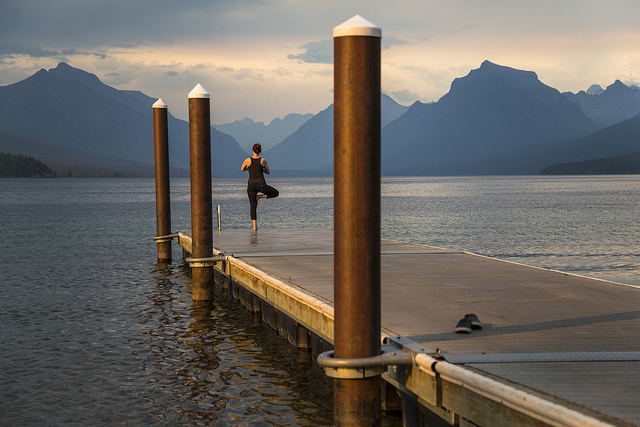It sounds simple, but it is hard to do. Finding that point outside of ourselves to focus on—a drishti––as yoga practitioners call it.
Tree pose looks easy. We stand on one leg, as the other presses against it bent in a V-shape. We raise our arms like branches. Yet it is so hard to find balance. We get distracted, feel self conscious, and we fall.
Losing balance is nothing more than losing touch with ourselves—losing focus.
Some days, it is harder to balance on one side than the other. In those moments, we may wonder why balance that was so easy to hold on one side is now so difficult on the other. We criticize ourselves for being weak or not trying hard enough. The negative dialogue rages on and our balance falters. For it is with a still mind, that we find calmness in the body.
We cannot balance the weight of our limbs with thoughts that make us dizzy—that is why we need to find a stillness outside of ourselves to remind us how stillness feels within.
In my practice today, I felt my left leg waver as it raised to my right thigh. I tried to find roots in my right leg, engaging the muscles of my thigh—but the tighter I clenched those muscles, the more I wavered, and my left toes kept brushing the ground.
Why couldn’t I get this? What was I doing wrong? I just did this yesterday.
I wanted to sit on the floor and watch the room around me. I wanted my body to stop moving. I did not want to fall. In that moment, as my thoughts were just about to win, I saw a notch in the wooden floor that reminded me of a rose petal. Intrigued by its shape and the richness of its dark color in comparison to the honey colored planks of the floor, there was silence.
When we lose our balance, we are at war with our internal dialogue and our external perceptions. Which one will win is a matter of learning how to find balance. A drishti is nothing more that that focal point that redirects us of our center and stops the war. It reminds us that we have control over our thoughts and our body—and with that control we can achieve a harmony.
To cultivate this balance between the ongoing duality that can distract us is the essence of practicing asanas or poses. Once we find our balance, we are free of the duality that feels like an internal tug of war or a state of confusion, and we find peace. A drishti can be a shadow on the floor, a water bottle—anything that removes us from our preoccupation with our internal dialogue and redirects our focus back to our senses.
Asana is often referred to as a meditative seat. It is a physical pose or a state of mind that we intended to hold. An asana is a comfortable pose where we can calmly observe our surroundings. It is a state in which we develop an awareness of not only that which surrounds us but our internal dialogue. We become careful observers, letting it all happen without judgement.
An asana, a pose is like the decision we make in every day life. A decision is based upon the information we receive from our senses. In order to make a decision, we must be free from the confusion that comes when we have a rapid inflow of thoughts. Whether the movement is with our thoughts or in our bodies, we must find that place of stillness in which to balance it all.
A drishti is that focal point, like the center of a seesaw where both sides of our awareness external and internal unite—and when all is quiet, we cannot not fall.
Somedays we will get it, and other days we will waver. Stop taking it so seriously—then you will discover it all.
.
Author: Jane CoCo Cowles
Editor: Yoli Ramazzina
Photo: Flickr/GlacierNPS







Read 0 comments and reply